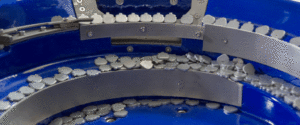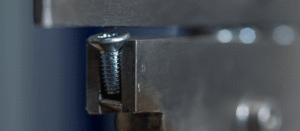Worcestershire, UK
Sandy Lane, Stourport, DY13 9QB
Send us a message
We reply within 1 day
+44(0)1299 823158
Available 9am - 5pm, Mon-Fri
Sandy Lane, Stourport, DY13 9QB
We reply within 1 day
Available 9am - 5pm, Mon-Fri
Shop hundreds of Toggle Clamp options from Sandfield Engineering – the clamp experts since 1965.
Sandfield Pneumatic Clamps are ideal for automated or repetitive holding applications.
A bowl feeder, or a bowl feeding system, is an accurate and efficient tool for sorting, ordering and orienting components and delivering them into a manufacturing or packing process at a specific feed rate.
Bowl Feeders are typically positioned at the start of a manufacturing process, an operator places a number of parts into a bowl or resevoir, the vibratory bowl feeder will then sort and orientate the components which are then fed into a linear or a nest as the first step in the production line or an index table ready to be fed into the machine.
Manufacturers and packers use bowl feeders because it removes the need to manually sort, orientate and load components. Instead of using an operator for the whole process, the operator is only required to load the mass of components into the bowl feeder and then they are free to complete other operations.
Bowl Feeding Systems are not a new technology, but they are still a cost effective option when compared to using operators or newer technology like picking robots. It is usually the case that if a business comes to us for a bowl feeding system they will already be using one, it is quite rare that somebody comes to us for a bowl feeder because they are looking to automate the process for the first time.
It might be interesting now with the UK leaving the EU and a reduction in migrant workers we could see more businesses automating these processes for the first time.
A newer development in bowl feeding systems is what they call check bowls. We have worked with Jaguar Land Rover who have parts that need to be checked to ensure that they meet the specified tolerance before they are introduced into the manufacturing process. The check bowl process involves the components passing a camera or sensor which detects that the components are correct. Any components that fail to meet the correct specification are removed to ensure that only the right components are packed and distributed.
Bowl Feeding systems perform a number of valuable functions in a host of manufacturing and distribution situations. It’s not just about assembling parts, often bowl feeders are used in quality control to check that the parts are right before being sent to the next stage in the process.

Bowl feeders deliver increased efficiency through their speed, accuracy and reliability.
Our experience is that Bowl Feeders are typically twice as efficient as feeding components manually. Because this a mechanised process bowl feeders achieve a consistency that an operator simply can’t. Even the most diligent operator is likely to make mistakes, miss components that don’t meet the required specification or tire over a long shift and slow down.
The efficiency that you achieve by using a bowl feeder is almost entirely dependant on the quality of the components that you are feeding. If you are introducing components of the wrong tolerance that is likely to cause a jam and impact efficiency negatively. Providing you are loading components that are the right shape, size and weight a bowl feeder will consistently sort and orientate those components for as long as required.
Bowl feeding systems are actually pretty durable pieces of kit and there is actually very little that can go wrong with them. Bowl Feeders don’t actually involve any moving parts, there is just a current that runs through it that causes it to vibrate, so there is very little that can actually go wrong. As long as your bowl feeders are calibrated correctly from the outset you should enjoy many years of rarely interrupted service.
There are only three real issues; components, users and oil. Components we have discussed already, essentially if the components are right they won’t cause issues. Occasionally you might get a foreign object in the flow which will cause a jam but that would be very rare.
The trouble with users if they aren’t competent with the kit, is that they may misuse it and that, of course, can cause problems. If for example an operator overfills the bowl feeder with components, or uses the bowl feeder to store components, that is likely to cause jams. The second issue is how the operator reacts to a jam. If a user decides that there is a jam, or the feed rate isn’t right or think that there is some issue with the bowl they tend to turn them off. Bowl feeders aren’t like computers where if you have a fault you just turn it on and off again. As long as the bowl feeder is running it will essentially be moving the parts, and keeping the parts moving is the most effective way to clear any jams. Typically if the bowl is jamming it will just need a minor adjustment that is required to get it operating effectively again, the danger with turning them off is it may be a period of time before they are turned on again and productivity will be lost.
The worst enemy of a bowl feeding systems is oil, because bowl feeders rely on vibration for the components to feed through the bowl, but if you use oil in the bowl, then obviously, the components can’t grip on that surface. This will depend on the brand of oil that you are using but one thing is for certain, if your bowl feeder is saturated in oil, really saturated in oil, it won’t work because it won’t have the friction to feed. If oil is an essential part of your process we have occasionally put a textured line in the bowl to break off the oils. But, I would say, that oil is the main enemy of bowl feeders and if you can avoid getting oil into your bowls they will function much more effectively and efficiently.
The only other issue is wear and tear overtime which might cause the calibration to get knocked out of kilter, although this also extremely rare. As long as the bowl feeder isn’t misused and is maintained effectively they will last for many years.

In lots of cases the customer will be simply replacing a bowl that they have had in operation already, in these instances it is a relatively straight forward process to re-engineer that bowl feeding system.
In instances where they are introducing a bowl feeder for the first time they typically won’t be able to provide us with anything more than the size, shape, weight and material of the components, the space they have available, the distance it needs to be from the machine and the desired feed-rate.
You know, so if it’s, if it’s something that, but what, what basically what people do when they come for a requirement, they, they say, “Look, this machine runs it. I want 120 components and beneath at your bowl feeder and this bore orientation.” So, you show, as a bowl solo, I would say, well, 120 keep up with the machines if the bowl feeder’s not working all the while and we’ve got a reservoir of parts waiting to be sorted. So that’s the way I would approach it. If somebody says to me, “My machine runs at 50 parts and many times you get at best 75 to 100 parts so many times at the bowl.
The interesting thing about thing about bowl feeders, and the thing that distinguishes them from almost every other piece of equipment that you might find on a production line is that you will never get a drawing, or even a technical spec other than the amount of space they have to accommodate the bowl, the clearance they need around the bowl to load it, the size, shape, weight and material of the components to be fed and the desired feed-rate. Getting the components to feed at all, and at the desired rate and orientation is all done by trial and error, by touch and feel.
What typically happens is that a business will approach us with a bowl feeding requirement and provide us with a sample of the component that needs to be fed. We would then use a test bowl that is as similar to the specification that they require and start trying different things until we start to get the components to feed, then we can start looking at the orientation and only then can we look at ramping up the feed-rate.
The reason that we don’t get, or even produce our own drawings, is because it is physically impossible to draw, because it’s actually impossible to predict accurately how the components will react in the bowl feeder. Calibrating a bowl feeder is essentially an exercise in playing around with it until it’s right, of course, overtime you get better at it and the solution comes together quicker. However, we have never calibrated a bowl feeder without some of this toing and froing – this is why people sometimes describe calibrating bowl feeders as a black art, it might be more appropriate to describe it as an acquired skill.
Sandfield provide a complete bowl feeding service from specification, design, testing, implementation, servicing and maintenance.
As long as the business can provide us with a sample of the component we are happy to explore the possibility of feeding it through a bowl feeding system. The only real limitation is the size and weight of the component, components that are too big or too heavy will not feed.
Sandfield also provide a servicing, relining and repurposing service which can either happen on the customers site or in our UK offices.
Sandfield have provided bowl feeders for all sorts of weird and wonderful applications including lego pieces which was a challenge because they are obviously different shapes.
Perhaps the most interesting application was cheese packing. The customer were packing cheese for distribution to hotels and restaurants and had come to the realisation that they were giving away too much cheese. The issue they were facing was inconsistency in the amount of cheese that was being packed. Even though the portions were small and the discrepancies from portion to portion impossible to discern by eye, over a shift, where thousands of packets would be packed it would add up to significant losses.
We produced a bowl feeder that produced consistent sized portions on weight and also increased the output rate.



Sandfield Engineering has a range of several hundred different engineering clamps available in every variation of style, material, action, dimensions, finishes and power options to meet your specific requirements on short delivery times.

Sandfield Engineering Company are the toggle, power and bespoke clamp experts. We design and manufacture engineering solutions that keep production lines running smoothly. We provide custom engineered solutions, prevent water pollution and drive increased efficiency through automation.
Protected by SSL Encryption
| Cookie | Duration | Description |
|---|---|---|
| cookielawinfo-checkbox-analytics | 11 months | This cookie is set by GDPR Cookie Consent plugin. The cookie is used to store the user consent for the cookies in the category "Analytics". |
| cookielawinfo-checkbox-functional | 11 months | The cookie is set by GDPR cookie consent to record the user consent for the cookies in the category "Functional". |
| cookielawinfo-checkbox-necessary | 11 months | This cookie is set by GDPR Cookie Consent plugin. The cookies is used to store the user consent for the cookies in the category "Necessary". |
| cookielawinfo-checkbox-others | 11 months | This cookie is set by GDPR Cookie Consent plugin. The cookie is used to store the user consent for the cookies in the category "Other. |
| cookielawinfo-checkbox-performance | 11 months | This cookie is set by GDPR Cookie Consent plugin. The cookie is used to store the user consent for the cookies in the category "Performance". |
| viewed_cookie_policy | 11 months | The cookie is set by the GDPR Cookie Consent plugin and is used to store whether or not user has consented to the use of cookies. It does not store any personal data. |